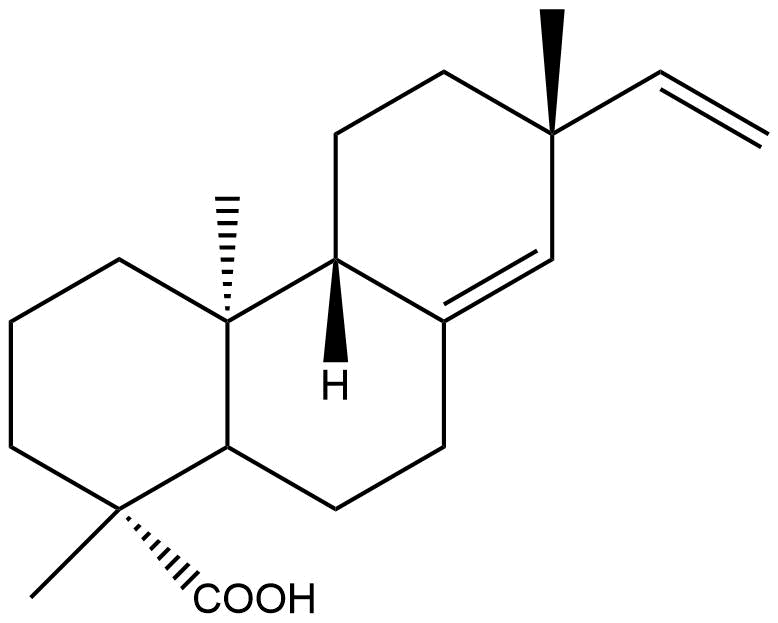
Continentalic acidCAS No.:19889-23-7
|
||||||||||
 |
|
|
||||||||

| Catalogue No.: | BP2057 |
| Formula: | C20H30O2 |
| Mol Weight: | 302.458 |
Product name: Continentalic acid
Synonym name: Pimaradienoic acid
Catalogue No.: BP2057
Cas No.: 19889-23-7
Formula: C20H30O2
Mol Weight: 302.458
Botanical Source: Acanthoppanax gracilistylus W. W. Smith.
Type of Compound: Diterpenoids
Purity: 95%~99%
Analysis Method: HPLC-DAD or/and HPLC-ELSD
Identification Method: Mass, NMR
Packing: Brown vial or HDPE plastic bottle
Storage: Store in a well closed container, protected from air and light. Put into refrigerate or freeze for long term storage.
Whenever possible, you should prepare and use solutions on the same day. However, if you need to make up stock solutions in advance, we recommend that you store the solution as aliquots in tightly sealed vials at -20℃. Generally, these will be useable for up to two weeks.
The product could be supplied from milligrams to grams
Inquire for bulk scale.
For Reference Standard and R&D, Not for Human Use Directly.
Description:
Continentalic acid and kaurenoic acid are quality control markers in Aralia continentalis. Continentalic acid has anti-inflammatory, anti-cancer, and anti-bacterial activities, it shows moderate cytotoxicity against A-549 (lung), THP-1 (leukemia) and MCF-7 (breast) cell lines; it has minimum inhibitory concentrations (MICs) of approximately 8-16 microg/mL against S. aureus, including the MSSA and MRSA standard strains.
References:
Indian J Pharm Sci. 2015 Nov-Dec;77(6):792-5.
In vitro Cytotoxicity of Methanol Extract from Aerial Parts of Aralia cachemirica and Purified Continentalic Acid.
The present study was designed to evaluate the in vitro cytotoxic effect of methanol extract of aerial parts including stems, leaves and twigs of Aralia cachemirica and purified Continentalic acidisolated from this extract against a panel of human cancer cell lines of varied tissues.
METHODS AND RESULTS:
Percentage of growth inhibition was evaluated by sulphorhodamine B assay. Purified Continentalic acid showed moderate cytotoxicity against all the cell lines used. In contrast, the extract exhibited significant concentration dependant cytotoxicity against A-549 (lung), THP-1 (leukemia) and MCF-7 (breast) cell lines.
CONCLUSIONS:
This work highlights cytotoxic potential of this extract, which can further be explored for different constituents for their possible use autonomously or in combined manner in cancer therapy. The detailed analysis of their cytotoxicity has been presented in this paper.
Arch Pharm Res. 2009 Sep;32(9):1237-43.
Anti-inflammatory activity of the constituents of the roots of Aralia continentalis.
METHODS AND RESULTS:
To assess the anti-inflammatory activity of the constituents of the roots of Aralia continentalis, ent-pimara-8(14),15-diene-19-oic acid (Continentalic acid, pimaradienoic acid, compound I), 7beta-hydroxy-ent-pimara-8(14),15-diene-19-oic acid (compound II), 7-oxo-ent-pimara-8(14),15-diene-19-oic acid (compound III), 15alpha,16alpha-epoxy-17-hydroxy-ent-kauran-19-oic acid (compound IV) and ent-kaura-16-en-19-oic acid (kaurenoic acid, compound V), their inhibitory effects against cyclooxygenase-2 (COX-2)-catalyzed PGE(2) and inducible nitric oxide synthase (iNOS)-catalyzed NO production by lipopolysaccharide-treated RAW 264.7 cells were examined.
CONCLUSIONS:
Taken together, the results of this study suggest that some constituents of A. continentalis, especially compounds I, III and V, exert significant anti-inflammatory activity, which suggests that these constituents contribute, at least in part, to the anti-inflammatory action of the roots of A. continentalis.
Phytother Res. 2006 Jun;20(6):511-4.
Continentalic acid from Aralia continentalis shows activity against methicillin-resistant Staphylococcus aureus.
METHODS AND RESULTS:
In a continuing search for compounds with antibacterial activity against methicillin-resistant Staphylococcus aureus (MRSA), a chloroform extract of roots of Aralia continentalis was found to contain Continentalic acid (CA, C(20)H(30)O(2)), a diterpenic acid. This compound exhibited potent activity against standard methicillin-susceptible Staphylococcus aureus (MSSA) as well as clinical isolates of methicillin-resistant Staphylococcus aureus (MRSA). It was determined that Continentalic acid had minimum inhibitory concentrations (MICs) of approximately 8-16 microg/mL against S. aureus, including the MSSA and MRSA standard strains.
CONCLUSIONS:
Therefore, the results obtained in this study suggest that Continentalic acid might have potential as an adjunct in the treatment of antibiotic-resistant bacteria.